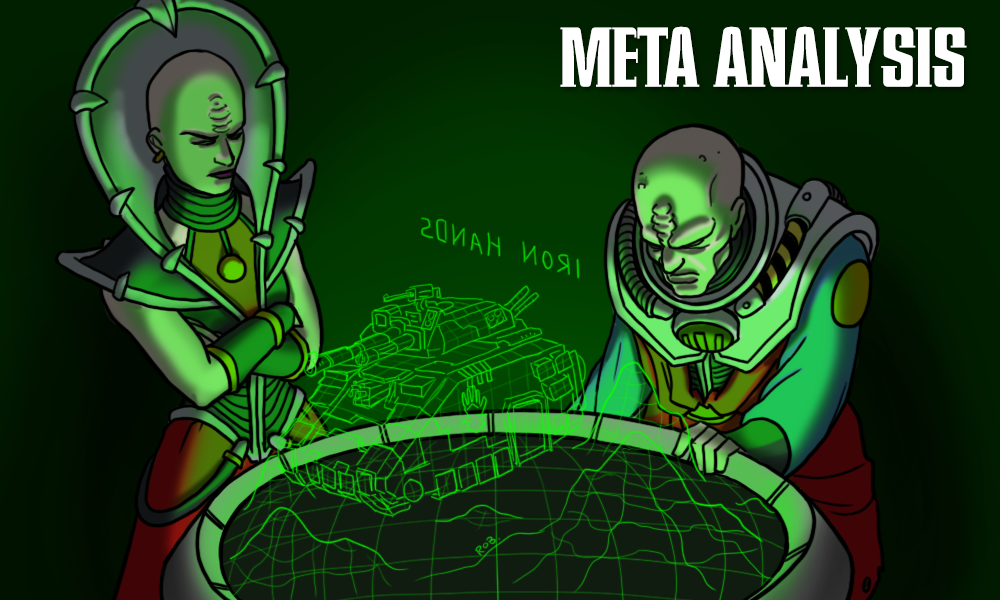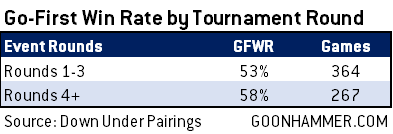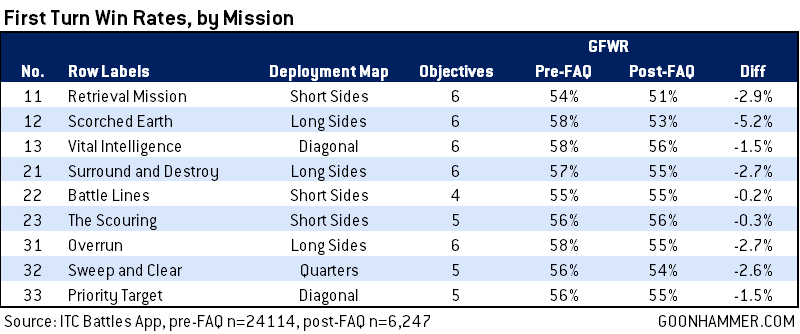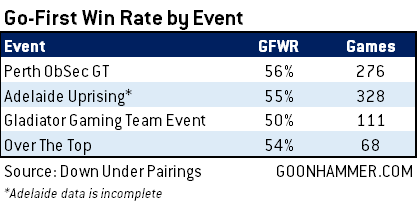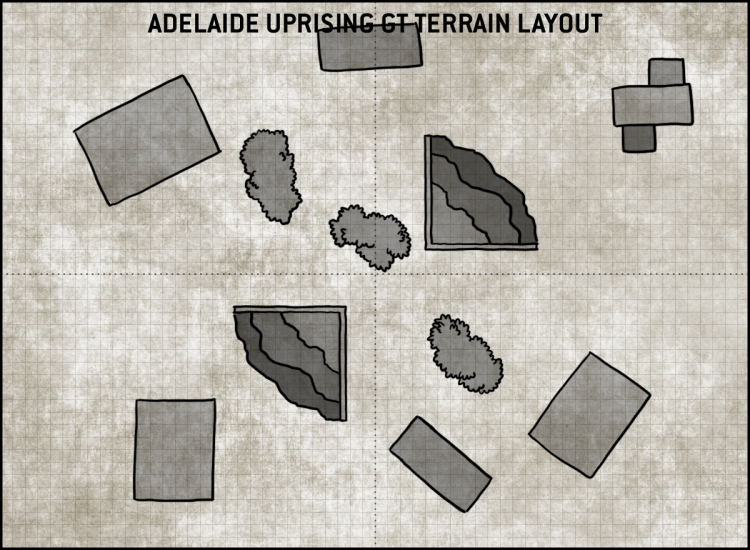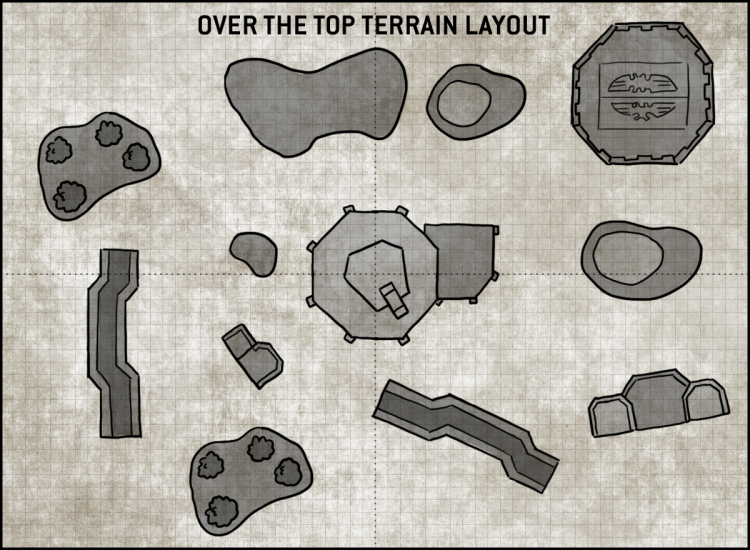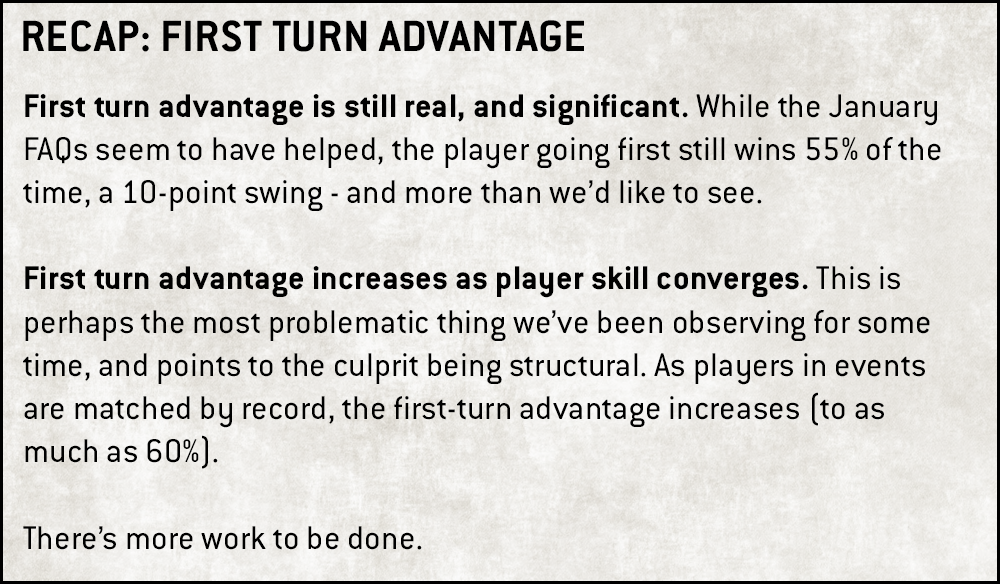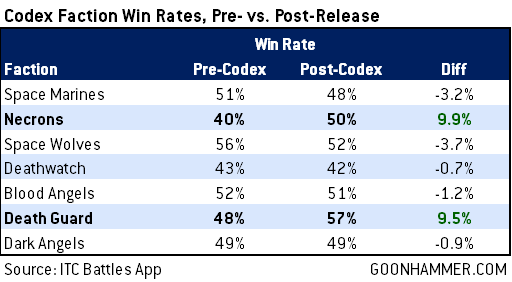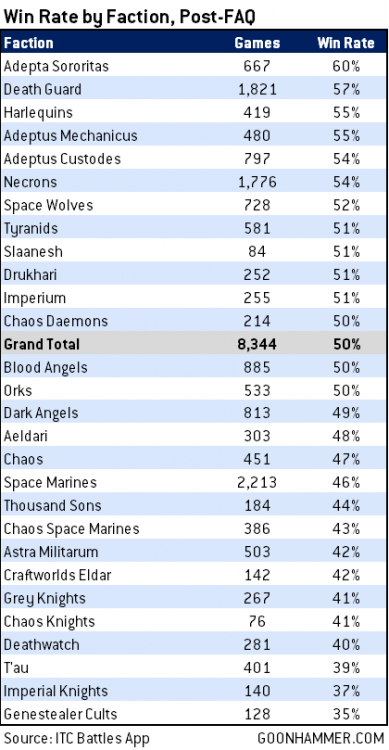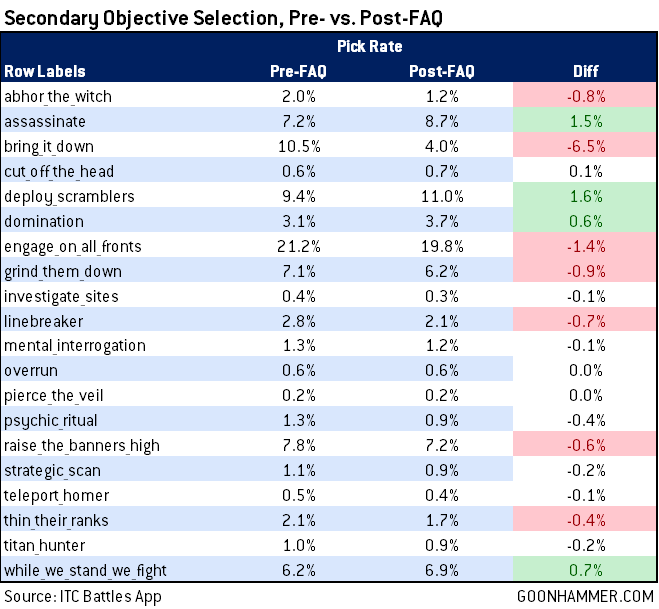Welcome back, dear reader! It’s been a little over a month since our last update and while there haven’t been any new codexes, there’s been plenty of time to evaluate some of the more recent changes and their impact on the meta. In some ways, the slowdown is a boon – it gives us more time to see the meta develop before the next explosive release, and that’s particularly important when it comes to collecting data from games when there’s a very limited number of events being run.
Methodology
Thanks to the wonderful efforts of tournament organizers and app developers around the world, we have access to what is essentially every meaningful piece of data around competitive games of 40k. The data in this month’s study comes from:
- Best Coast Pairings/Down Under Pairings apps, the premier way to run, manage, and track results for tournaments
- The ITC Battles App, a brilliant app for tracking games both in and out of tournaments and a great source of casual game data worldwide
With tournament activity currently still slowed in most areas thanks to the pandemic, we were still able to analyze data on more than 8,300 games of 40k played since the January FAQs dropped, and there have been several large events run in Australia and New Zealand to look at with regard to tournament data.
What We’re Covering This Month
Just because we haven’t seen the release of Codex: Drukhari doesn’t mean we don’t have a ton to look at. Last time around it was still early days on the changes from the January 2021 FAQ; we now have many more games to look at and can really dig into those results and see how things have changed.
Is having the first turn still a significant advantage? – YES
One of the major questions we’ve been addressing over and over in these analyses – and in fact one of the major drivers of starting this column – was whether going first in the 9th edition 2020 GT Missions Pack gave a player an unfair or outsized advantage. Two changes in the January FAQ seemed squarely focused on reducing this impact, specifically:
- Forcing the player who wins the roll-off to go first (removing the option to choose to go second), and
- Changing primary scoring so that primary scoring for the player going second occurs at the end of their fifth turn instead of during the Command phase.
We looked at this one month ago and determined that there hadn’t been much of a change from the new rules but it was still early days and we didn’t have a lot of data. Well, we’re now one month in and we now have data on nearly 7 thousand games in the ITC Battle App and more than one thousand tournament games logged in Down Under Pairings since the January FAQs dropped.
The overall results still show a significant (and similar) advantage for the player going first in the post-FAQ era, regardless of whether they’re playing in casual games or the GT level.
 Looking back on our prior analysis, we can see how this new rate compares to the old and where things have shown a bit more movement.
Looking back on our prior analysis, we can see how this new rate compares to the old and where things have shown a bit more movement.
This new rate – about 55% – is a small but statistically significant decrease from the pre-FAQ number, but not so much from our initial post-FAQ analysis, where we saw something between 55 and 56% win rates for the player going first. It’s an improvement, but not enough to change the fact that there’s a 10-point swing in win rates between going first and going second.
We’ve previously seen arguments that better players often prefer going second, forcing their opponents to make poor initial plays. This has been countered by our data on multiple occasions, which shows that as player skill becomes more even in the later rounds of an event, go-first win rates increase. Is that still the case, though?
Does going first confer a greater advantage later in events? – YES
All of the data we’ve collected since the FAQ from GT-sized events with 5 or more rounds suggests that, yes, going first is an even bigger advantage in later rounds, where record matching is likely to pair players of similar skill levels against each other. Go-first win rates for games played in rounds 4+ are 58%, significantly higher than games played in rounds 1-3, and massively higher than round 1, where the player going first won only 48% of their games, albeit over a sample of only 125 games. This then increases to around 60% in the final rounds.
A disparity in skill can make up for this advantage early on but as players become more evenly matched, the structural advantages of going first become harder to overcome.
What does the ideal go-first win rate look like?
While we were working on this, Dexefiend posed a question: “Chess, which is pretty balanced, has a 55% win rate for white. Is there not some irreducible advantage for going first?”
This is a good question, and something that’s worth addressing as we do this. First off, it’s important to note that 40k is not like Chess – 40k is a much less symmetrical game than Chess and, unlike chess, it’s possible to change the rules for 40k and particularly the mission structure for tournaments. There are many other factors that can affect a player’s likelihood to win before the game begins but most of these factors – such as list construction or what army to bring – are in a player’s control, and may be counterable. Players will already be in a situation where matchup dynamics may give them an outsized chance to win and so in an ideal scenario, random effects that improve win rate would be limited as much as possible.
To that end, we’d suggest that something in the 47-53% range (maximum 6-point swing) is the ideal go-first win rate, suggesting a mostly fair game with some slight – but counterable – first turn advantage for certain specific factions or in certain matchups. Based on our data from the final periods of ITC 8th, first turn win rates in hovered in the 52-53% range, and player consensus was largely that first turn was not an issue, with other factors being a much stronger determinant of who won a given game. Perfect 50:50 balance is unlikely to ever be possible, but given what was demonstrably achievable in the previous edition we think a 53% first turn win rate is a reasonable marker to use as a goal.
That means that, in an ideal scenario, further adjustments are still needed to get us from a 55% go-first win rate down to something below 53%.
What about the mission?
Something I covered in our recent Hammer of Math on missions in the 2020 GT missions pack was that missions seem to have a clear impact on go-first win rates that is primarily in-line with the benefits we’ve seen for missions as a whole. Unfortunately, this is an area where we don’t have enough data from BCP/DUP to do the same analysis for tournament games post-FAQ – there just haven’t been enough large events reporting that data.
That said, the changes to missions from the FAQs appear to have affected missions differently. In particular – there’s a much stronger impact (r=0.68) on missions with more objectives, and the average drop on go-first win rate was 2x larger on missions with 6 objective markers compared to 5.
Wings: 6 objective missions seeing a greater impact from the changes broadly makes sense gameplay-wise. The advantage the second player now has is that, even with a relatively small number of resources on the board, they can move them to optimise their score in their final turn, meaning any unoccupied objective is a potential source of points. With six on the table, it’s just that much more likely that in a close game there will be enough free to grab to bump up your final turn score by 5pts – which from our previous analysis is about the margin needed to close the gap.It’s notable that this is less pronounced on Vital Intelligence, and that’s likely to be a mix of it being a Domination mission and the central objectives being quite clustered, making it easier for player one to leave enough units to protect them.
Something else we pointed out last time – that still seems to be the case – is that deployment map is also likely a factor. This was true before the FAQ changes, and appears to be less true after, though this is in part because of the large drop in go-first win rates for games played on the Scorched Earth mission. It’s worth continuing to look at these results in the future, particularly as we get more tournament game data post-FAQ.
Even with some missing games that prevents us from doing by-round data for Adelaide, we have four events that feature what we might consider relatively sparse terrain and the tournament with the most dense layout – Perth – has the highest Go-First Win Rates, suggesting that terrain isn’t nearly as big a factor as people are making it out to be.
What about the Terrain?
We’ve talked a bit about terrain before. There’s almost certainly some impact you can trace to terrain on mitigating the turn 1 advantage – being able to hide your entire army will make it so your opponent’s ability to do damage on turn 1 is limited, but it’s important to note that damage is only one part of the turn 1 advantage. The biggest challenge with terrain is that it’s very hard to quantify, and it seems like there are other factors that have a much bigger impact on go-first win rates, such as deployment map, number of objective markers, the round, and whether it was a team event.
Additionally, if there’s some kind of ideal terrain setup for an event, we haven’t seen it yet. The GTs we have data for in Australia and New Zealand since the January FAQ update do not appear to have the kinds of terrain that would lead to lower go-first win rates, and in fact the varied nature of the layouts suggests that the advantages of going first are more structural than based on the natural downsides of IGOUGO play.
Objective Secured Perth GT – 56% Go-First Win Rate
Adelaide Uprising – 55% Go-First Win Rate
Over The Top GT Layout – 54% Go-First Win Rate
Gladiator Gaming Team Event – 50% Go-First Win Rate
These are some pretty varied terrain layouts, but they drive pretty much the same result, save for the Gladiator Gaming Event, which suggests that Team Events may have lower Go-First Win Rates because of how they are structured.
Wings: The pairing process used in team events is likely to be a confounding factor here (you can read my write-up in Competitive Innovations if you want to learn how it works). Between teams putting forward sacrificial “defender” lists and dropping counterpicks on each other, the resulting matchup disparity is likely to significantly flatten out the impact of the first turn on the results of any given game.
It’s also worth mentioning the current WTC Team event going on, which uses much heavier amounts of terrain. As of this writing on Saturday, two rounds had completed with an average go-first win rate of 52%. That’s good in that it’s within our desired range of outcomes, but bad in the sense that:
- This is only for the first two rounds, where we’ve seen lower GFWRs traditionally anyways, and
- The two missions played – Retrieval Mission and Scorched Earth – have the lowest average GFWRs to begin with, and these values are in line with our measured values from the ITC Battles App.
Note that the below is an example of a WTC Team Tournament layout. The event has many different layouts for different missions, but they all share the trait of being absolutely packed with terrain.
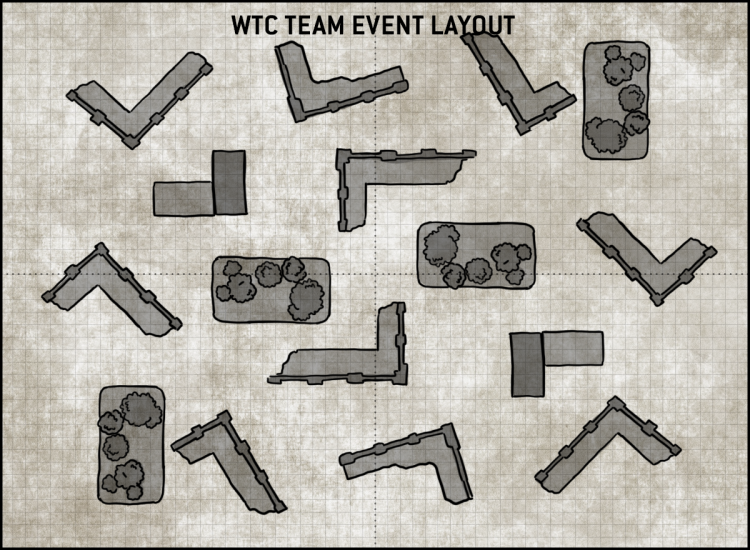
Additionally, the WTC event is a team event, which gives players the flexibility to control their matchups – the game will generally be weighted to one side at the start, and the advantage of going first is likely to be less of a factor than the matchups.
Even with all that, go-first win rates in the first two rounds have been in-line with what we’ve seen in other events.
All of these things together suggest that terrain doesn’t really matter that much. And this makes some sense in that players attending events will often have a good idea of the amount of terrain they can expect to see before they build an army, meaning that they can adequately prepare for the layouts, whether they’re on planet bowling ball or it’s wall-to-wall jungle.
How Has Primary Scoring Changed?
One last thing to look at here is primary scoring and the changes around that. In our prior analysis, we identified a 3.7-point difference between going first and second for the losing player. How have the primary scoring changes for the player going second affected this?
The biggest observable difference is that the player going second now scores an average of 1.2 more VP on their turn 5. This is a significant improvement, but not enough to overcome a 3.7-point deficit, and aligns with our results showing a statistically significant decrease in first turn advantage, but not a large enough one to solve the problem.
Given the earlier observations we made around mission and number of objective markers, it’s likely these effects are larger on missions that use 6 objectives.
How Has Faction Balance Changed Since the January FAQs?
Of course, the big changes haven’t all been to the structure of missions and scoring – we’ve also seen the release of two new codexes since – Death Guard and Dark Angels. And with those, we’ve seen an explosion of games being played with each, similar to what we saw for Necrons.

With the exception of main book Space Marines, the share of games played for armies tends to double following the release of a new codex, though Necrons more than tripled their pre-Codex share of games played – this was in part because of players dropping “Nurgle” as a faction in favor of monofaction Death Guard. Currently Drukhari sit at just below 2% of games played – expect that number to jump to around 5% following their Codex.
Marines have been the big loser since the start of the edition and it’s not hard to guess why – other books have eaten into their share, particularly those featuring other marines chapters.
Win rate is another story – not every book has a substantial impact on a faction’s win rate. In fact, of the 9th edition codexes, only two – Necrons and Death Guard – saw significant increases in win rates following the release of their new books.
The lack of movement on the marine chapters also likely reflects that these factions had Index updates prior to their codexes to help them “get by” prior to their codex releases.
Are Death Guard and Dark Angels overpowered? – Maybe?
With any new faction and ruleset that introduces powerful new rules to the game there’s always going to be accusations of broken-ness in the new rules. But as is often the case, those aren’t borne out by results. In this case however, we’ve seen a massive jump in effectiveness for Death Guard – to 57% win rates, and a slight/non-significant decrease for Dark Angels.
This seems to indicate that new Death Guard are overpowered and new Dark Angels are underpowered… but tournament results haven’t shown that so far – Death Guard still struggle from a TiWP standpoint – winning lots of games but not necessarily converting that into high-level tournament wins. And as we’ll see in Competitive Innovations on Wednesday, there are some incredibly good Dark Angel Ravenwing builds that are likely to significantly overperform the faction averages.
So the answer is “maybe, but we definitely need more data and results before we jump to calling either faction over or underpowered.” In another month we may find that some Dark Angels lists are oppressively good while Death Guard are merely gatekeepers, capable of cleaning up at the midtables but rarely able to overcome top lists.
Are Harlequins still the army to beat? – Yes, but they have stiff Competition
Harlequins are still a dominant force, as our updated Glicko ratings will show, but now face very strong competition from Death Guard and Sisters of Battle, each of which has posted very high win rates since the January FAQs dropped. This may be something that evolves over time, particularly if the number of Sisters players increases following the release of their upcoming boxed set that gives them access to a new Lieutenant-like unit, and if Codex: Drukhari proves to be extremely powerful. In overall win rate post-FAQ, the Adepta Sororitas topped our stats with a 60% win rate.
While Necrons have held pat, Space Marines have been struggling a bit, posting a 46% overall win rate since the new FAQ dropped, though there was little to affect them directly in it.
Glicko Scores over the last 30 days show a similar trend, with rapid growth from Death Guard as Sororitas and stay close behind. Some of the big losers over the last 30 days? White Scars, who dropped significantly thanks to a 50% overall win rate, and Imperial Fists, who just plummeted over the course of the month thanks to an absolutely abysmal 34% win rate. Which seems odd, given that vehicle targets may be more plentiful than ever but keep in mind it’s also much harder to actually max Bring it Down even with more vehicles on the table. Please press “F” in the comments below to pay your respects to Jack “BenBooley” Hunter. It should also be noted that if the headline 46% win rate for Marines “feels” low to you, weaker chapters pulling it down is probably a contributor.
Secondary Objectives
Finally we’ll be touching on secondary objectives again. This is something we’ve talked about a few times now, looking at how secondary picks impact scoring, but with six new faction-specific secondaries and changes to key secondaries in place, it’s worth revisiting some of this discussion again.
To recap, the following secondary objectives changed in the January FAQ:
- Scoring for Bring it Down changed to award 1 VP for each VEHICLE or MONSTER with 10 or fewer wounds destroyed (down from 2VP), 2VP for one with 11-19 wounds destroyed (down from 3VP) and 3VP for those with 20+.
- Abhor the Witch awards 3VP for each PSYKER CHARACTER destroyed (down from 5VP) and 2VP for each other PSYKER destroyed (down from 3VP).
- For While We Stand, We Fight, your three most expensive Units rather than Models now become the things you need to keep alive.
- There was a ruling in the FAQs clarifying that, while Psychic Actions are not technically Psychic Powers, attempting one functions identically to manifesting a psychic power, and all rules that interact with that process apply here too.
These are some interesting changes and there are a few things worth looking at here – some of these will impact scoring and how often certain secondaries are taken – the ruling on Psychic Actions makes them very, very bad against most armies, while others will have greater impacts on army composition – scoring for Abhor the Witch now makes taking more psykers less dangerous.
How Did the January FAQ change secondary scoring?
So when it comes to these secondaries, the January FAQ had a large impact. Less so on Abhor the Witch – though scoring for that secondary dropped by nearly a point on average – and more so for Bring it Down, where average scores dropped by more than 2 points. Scoring for the other psychic secondaries and While We Stand, We Fight did not seem to be significantly impact.
In addition to scoring we can also look at faction selection rates. In addition to dropping an average of 2.2 points with regard to average scoring, Bring It Down also dropped as a selection, going from a player choice in 10.5% of games to only 4%. Abhor the Witch also dropped, though given that it was only being taken 2% of the time the impact here was less severe. The secondaries that appear to have benefit here are Deploy Scrambers (+1.7), While We Stand, We Fight (+0.7), Domination (+0.6), and faction secondaries.
What do the stats look like on the Death Guard and Dark Angels secondaries?
Unfortunately it’s still too early to look at Dark Angels’ secondary objectives from a data standpoint, but we’ve seen some early indications from events that the Death on the Wind objective may be a real contender in competitive play – Wings will talk more about that in Competitive Innovations on Wednesday. In the meantime, we can talk about the Death Guard secondary objectives.
Of these, only two are worth talking about – Fleeing Vectors is universally regarded as terrible, and so hasn’t been picked often enough to look at. On the other hand, Despoiled Ground (15%) and Spread the Sickness (37%) have seen enough play to merit. Comparative, these are both pretty average, coming out to 7.2 and 8.2 points, respectively, against an average secondary score of 7.5. Comparatively, that’s well below some of the other notable faction secondaries, such as Oaths of Moment for Space Marines (9.7), Relentless Assault for Blood Angels (9.4), or either Treasures of Aeons (9.4) or Code of Combat (9.1) for Necrons. In fact, every one of the four Necron secondary options produced scores above the average, with the lowest being Ancient Machineries (7.7). Death Guard weren’t any more likely to win when they chose a faction secondary, either. By contrast, Necron players taking one or more faction secondaries was significantly more likely to win their game, with win rates as high as 58%.
Are Faction Secondaries too good? – It Depends.
This naturally begs the question – are the faction secondaries too good? After all, we’ve only seen six Codexes in 9th edition, meaning that another 25-odd factions are still completely lacking when it comes to having additional secondary objectives to choose from. On top of that, the marine subfactions have access to both sets of faction secondaries – the ones in their supplement and the ones in Codex: Space Marines, giving them incredibly flexibility when it comes to scoring. This has led many players to suggest that the faction secondaries aren’t fair, and some events have banned them altogether.
But is this the correct move?
It’s a difficult question to answer. Not because some of the faction secondaries aren’t strong – some of them are clearly better than the other options present to those factions, and both the Blood Angels and Space Wolves benefit from having access to Oaths of Moment on top of their own secondaries. Rather, it’s difficult to answer because there’s a larger picture to consider. Specifically, the faction secondaries are a part of the overall power level and balance of a codex, and theoretically they are created with that in mind. It’s worth noting that so far neither marines nor their double-secondary equipped subfactions (Blood Angels, Deathwatch, Space Wolves) are dominant in competitive play. Likewise for Necrons, who potentially have the best set of faction sedonaries. Meanwhile Harlequins, Daemons, and Adepta Sororitas are topping tournament scoring and doing so without special faction secondaries. Removing these from the table essentially issues a harsh nerf to marines and Necrons while doing nothing to hurt the game’s top factions. It is for this reason that I’d suggest it doesn’t matter if faction secondaries are very good.
On the other hand, there’s an argument to be made for the idea that we should do away with faction secondaries and be forced to balance books on the merits of their units and costs, and remove the asymmetry of choices from the game.
Let’s take a quick look at the current faction secondaries that we have enough data for. With an overall post-FAQ average of 7.4 points for non-mission secondary objectives (and a standard deviation of around 4), anything that averages 7.5 or higher for a faction is likely to be a decent secondary choice to build around or attempt, and anything worth more than 9 points on average can be considered exceptional, as post-FAQ none of the non-missions secondaries hit that mark (Bring it Down and Abhor the Witch used to). That means that Relentless Assault, Oaths of Moment, Code of Combat, Purge the Vermin, and Treasures of Aeons are all exceptional secondary objective selections, and Blade of Sanguinius, Despoiled Ground, Ancient Machineries, Warrior Pride and Spread the Sickness should be considered decent, but more balanced as options.
With Necrons and Death Guard doing well you can certainly make the case that removing these will help factions that don’t have secondary objectives compete, though the reality is more likely to be that the other top factions – Harlequins, Daemons, Sororitas, and Custodes – just become more dominant.
What happens if we take Faction Secondaries out of the picture?
This is a tough question to answer, and one we’re still working on and waiting on more data for. We can do some quick back-of-the-napkin math on this to arrive at an approximate figure in the meantime, however. The short version is that there were 4,478 games in our sample where one or both players picked a faction secondary and of those 506 had a margin of victory of 3 points or fewer, indicating that they’d likely have been impacted by forcing a player with a faction secondary. Of those, 139 featured both players using faction secondaries, leaving us with 367 games whose outcomes could have flipped as a result of losing 1-3 victory points from secondary objectives. This leaves us with the following chart, showing a 2-3% point drop in win rates across each faction, with Space Wolves and Blood Angels taking the hardest hits. Death Guard also look bad but recall that this quick calculation is less likely to be accurate for them as their average secondary scores are significantly lower, and so it’s more likely that a more rigorous analysis would see them losing fewer games as a result of losing faction secondary points. Likewise, effects will be slightly greater still on Space Wolves and Blood Angels, the two factions most likely to double up on faction secondaries with Oaths of Moment.
 Not included here is the net impact on the win rates for factions that lack secondary objectives, which will only be positive as a result of these factions surrendering their “easy” points and losing 2-3% more of their games as a result.
Not included here is the net impact on the win rates for factions that lack secondary objectives, which will only be positive as a result of these factions surrendering their “easy” points and losing 2-3% more of their games as a result.
So ultimately the conclusion I’d arrive at is that faction secondaries don’t matter enough to make them worth banning… yet. If your take is that it’s only a matter of time before Games Workshop prints one so egregiously bad it needs to be changed via errata or an FAQ, then the preemptive move will likely hurt some of the upper-but-not-top tier factions with recent codexes, but not be so devastating that those armies will change standing dramatically. On the other hand, these secondaries don’t currently appear to be driving insane results for those factions either, suggesting that army balance has, so far, managed to take them into account well enough.
What’s Next?
That wraps up our March look at the meta but we’ll be back again in a month or so to look at the impacts of the Dark Angels’ new book and Codex: Drukhari on the meta, as well as revisit some questions around faction secondaries and look at what will hopefully be a much larger pool of tournament results. Until then, if you have any questions or feedback, drop us a note in the comments below or email us at contact@goonhammer.com.
